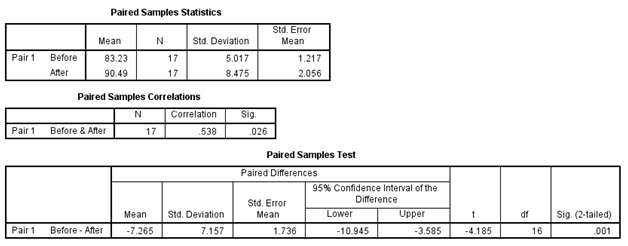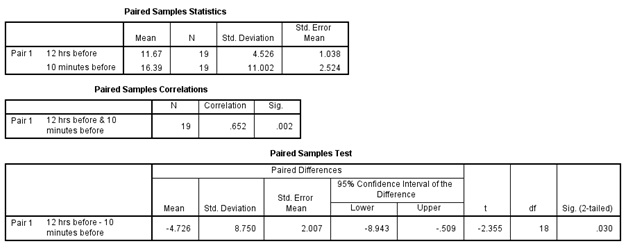Reference no: EM132595387
Practice Exercise 1
1. When is it appropriate to analyze data using a T Test for Dependent Samples?
2. What is meant by the term "dependent means'?
Use the Paired Samples T Test function in SPSS to answer each of the following questions. (Assume a nondirectional research hypothesis and a critical level of significance of .05)
A study was conducted on the use of family therapy as a treatment for anorexia. The study included 17 girls who were weighed before and after treatment. The weights of the girls, in pounds, are given below.

3. Write an appropriate null hypothesis for this analysis.
4. What is the mean weight of the girls before and after treatment?
5. What is the standard deviation of the weight measurements before and after treatment?
6. What is the observed or computed value of t?
7. How would you explain the procedure for determining the degrees of freedom for a T Test for Dependent Means?
8. What is the value of the degrees of freedom that is reported in the output?
9. Does this correspond to the value obtained using the formula for the degrees of freedom?
10. Based on the results of the T Test for Dependent Means, what would you conclude about the effects of family therapy on weight increase for girls with anorexia.
11. Write a statement as it might appear in an article that reports the results of the TTest for Dependent Means.
Practice Exercise 2: T Test for Dependent Means
Use the Paired Samples T Test function in SPSS to answer each of the following questions. (Assume a no directional research hypothesis and critical level of significance of .05)
Researchers interested in the effects of stress on beta-endorphin levels in the blood took beta endorphin level measures from 19 patients 12 hours before surgery and again 10 minutes before surgery. The data are presented below
SPSS output

Write an appropriate null hypothesis for this analysis.
2. What are the mean beta-endorphin levels of patients 12 hours before surgery and 10 minutes before surgery?
3. What are the standard deviations of the beta-endorphin levels 12 hours before surgery and 10 minutes before surgery?
4. What is the observed or computed value of t?
5. What is the value of the degrees of freedom that is reported in the output?
6. Based on the results of the T Test for Dependent Means, what would you conclude about the effects of stress on the level of beta-endorphins in the blood?
7. Write a statement as it might appear in an article that reports the results of the T Test for Dependent Means.